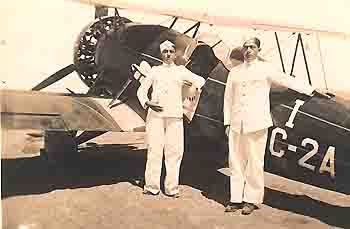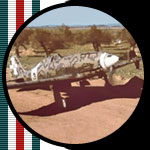STORMO! � 2009 1 (2009) 1-2
Caproni Ca.114 in Peruvian service 1935-4
Amaru Tincopa
December, 2009

The Caproni model 114 was designed
by Engineer Gianni Caproni as a fighter development from the highly
maneuverable Ca.113 acrobatic biplane. This
elegant biplane fighter�s structure followed the mixed construction method
usual for the period, with the fuselage frame built out of steel molybdenum
welded tubes covered with metal sheet and fabric, for the front and rear
surfaces respectively. Wing structure was entirely built of wood with fabric
covering, with the peculiarity of had the right wingtip extended in 7 cm in order to compensate the engine torque. All control surfaces were built of wood and also
covered with fabric. Both main and tail landing gear were fixed, with 750 x125
mm, brake equipped, FAST type III wheels fitted. Its length was 7,68m, height
2,68m and its wing span was 10.50m. Empty weight was 1,310kg, while maximum
weight was 1,656kg.
The prototype MM 233 flew for the
first time in the summer of 1934, powered by a 460 hp Piaggio Stella IX R.C.1.
This was to be the only Piaggio powered aircraft, as the following 12 machines
-built for Peru- were powered by Bristol Mercury IV engines, license built by
Isotta Fraschinni. Equipped with the latter it could reach a maximum speed of
355km/h, while its service ceiling was 4,500m. Internal fuel tanks give it a
range of 600 km @ � power.
Armament consisted of two fuselage
mounted Vickers 7.7mm machine guns with 500 rounds each. Spent
ammunition counters were provided for each weapon and located in the instrument
panel, while gun aiming was provided by the means of a bed sight. Other
equipment aboard the machine included a R.A.80/1 transmitter/receiver and an
AGR 61 photographic camera. Finally, the pilot cabin counted with complete
oxygen and fire suppression system.
The Ca.114 was the rival of the
famous FIAT Cr.32 in the 1934 Regia Aeronautica Fighter competition, beating
Engineer Celestino Rosateli�s design in most departments, including abilities
such as maneuverability, rate of climb and ease of maintenance. However, it was
not adopted by the Regia Aeronautica, probably due to a strong FIAT lobby in
favor of its own product. Peru, however, did show interest in the type due to
a strong rearming process after the conflict with Colombia and the fact that
it was the only fighter available in substantial numbers for a relatively low
price. Accordingly in late 1934 a purchase order was submitted to the Societ�
Italiana Caproni for 12 aircraft, spare parts including floats and a number
of engines. Peruvian Cuerpo �de Aviaci�n (Air Corps) was to become the first
-and only- air force to operate the Ca.114.
After a few months the new CAP fighter
began to arrive to El Callao harbor, and by April 1935, assembly and test
flight of all 12 machines had been completed. The machines sported a colorful
red and black scheme, certainly anti camouflage and more reminiscent of an air
racing aircraft.
By this time the conflict with Colombia was over and the peace was making
its way between the two nations, and the Caproni
fighters were never deployed in their intended role as seaplane fighters, and
the floats were never installed in any of the airframes. Consequently the
machines were put on strength of the 2nd Training Section-Fighter
and Aerobatics- under the command of Captain Luigi Bianchi -at the time
seconded by Caproni firm to test fly all Caproni aircraft being, or to be,
acquired by the Peruvian government- at the Air Corps Officer School at Las
Palmas airfield. Soon the Caproni fighters became very popular with both
pilots whom appreciated its excellent flying characteristics and by the ground
personnel due to its ease of maintenance.
During training, a flight of 4 Ca.114 flew to Chiclayo airstrip, 1,200 km from Lima, on April 21, 1935 as prelude of the creation of the
1st. Aviation Squadron airbase. The flight was headed by the very
same Ergasto Silva Guillen, who led his men to Chiclayo in an eventful flight,
where the men and their machines were greatly welcomed upon their arrival. The
return trip was realized without problems and the machines landed at Las Palmas airbase two days after.
After completing the operational
training cycle, pilots and machines were organized into three Escadrilles of
three aircraft each, which together formed the XXI Fighter Squadron of the 1st
Aviation Squadron. At the Central Aviation Depot the fighters received new unit
markings and radio call numbers, I-2C-1A to� I-2C-9A. On October 5 1935, at
10:00am the fighter group flew these machines to Chiclayo.
Meanwhile three remaining fighters
remained at Las Palmas, where they served as part of the aircraft complement of
the Jorge Chavez Aviation School. It was under the School management that the
Ca.114 force suffered its first accident. On the Morning of September 4, 1937,
Sub Alferez Enrique Fuller took off in aircraft E-C-7A (E=Escuela/School,
C=Caza/Fighter, 7th Avion/Aircraft) for routine aerial gunnery training. Things
went with no problems until landing, when the engine lost power forcing the pilot
to crash land the plane, luckily suffering only minor injuries in the process.
The machine sustained about 40% damage, and after that incident it was stored
at the National Aircraft Factory for use as a spare parts source, until its
definitive retirement on late 1940, when its remains were sent to the scrap
yard.�
Back at Chiclayo 1937 saw its 9
Ca.114s still intact and perfectly operative within the ranks of the 2nd
Fighter Group, 1st Aviation Squadron, still retaining its striking
original black and red painting, now decorated with the Squadron logo, which consisted
of an inverted top hat and a bast�n or walking stick.
During 1938 the Cuerpo de Aviaci�n
Peruano finally obtained its autonomy from the navy, thus becoming the Cuerpo
Aeronautico del Per� (Peruvian Aeronautic Corps). Later that year the Ca.114 fighters
of the 1st Back in Chiclayo, and after three
years of operations without any incidents, the unit suffered its first loss on
August 18, when Alferez Carlos Frias crashed its aircraft number I-2C-6A on a
farm field near its base. The pilot was seriously injured in the process and the
machine sustained 70% damage, resulting in a total wreck. The 1st
Aviation Squadron ground crews recovered all useful parts and the rest of the
aircraft was
sent to the scrap yard.�
Meanwhile at Las Palmas, the
aircraft used by the Aviation School were fitted with new propellers, which
were four bladed and made out of wood manufactured by FNA Caproni Peruana,
built with the aim of preserving the stocks of it metallic counterparts, and were
destined to be used only on training aircraft.
The Ca.114 fighters were usual
sights at the air parades held each year in Lima for the Aviation and National
celebration days, as well as at several other celebrations in other country airbases.
During early 1940, Ca.114 I-2C-4A
and E-C-11A, belonging to the 2nd Fighter Group and to the Fighter
Section of the School respectively, were present at the NAF installations
undergoing repair and modifications to their landing gear. During
operations it was noticed that wheel covers had a tendency to clog with dirt
and mud, and were often removed during the rain season.

On late 1940 the Air Ministry began
an Air Corps reorganization, which resulted in most units renamed or its
structure modified. Consecuently, 1st Aviation Squadron also was a
subject of those changes and it was now composed by one fighter and one bomber
Squadron. The fighter Squadron was composed of three new Escuadrillas (Escadrilles):
the 41st, equipped with six North American NA.50[i]
fighters, while eight Ca.114 composed the 42nd and 43rd
Escuadrillas. Consequently the radio call signs were changed, now consisting of
the Squadron number painted black in Roman numerals inside a red pennant on
the fuselage, followed by the Escuadrilla and the individual aircraft number in black
Arabic numerals. Also and in accordance to the new regulations, each
Escuadrilla was now to be identified by the coloring of the engine cowlings.
With growing tensions between Peru and northern neighbor Ecuador, 1st Aviation Squadron was designed to veil for the integrity
of the air space of the recently created Northern Operations Theater. The
fighter Escuadrillas were especially active during the early part of 1941, and
the training emphasized in escort and interception duties. It was on April 2,
1941 during one of such flights that Ca.114 XXI-42-3 flew by an unidentified
pilot crashed during low level maneuvers, severely injuring the pilot, while
the airframe sustain 60% damage After inspection by specialized personnel, the
remains were declared as a total loss and the useful parts sent to Lima, where
they were stored.
With the beginning of operations on
the first days of July, air supremacy and escort missions were entrusted to the
42� and 43� Escuadrillas, XXI Fighter Squadron, where elements of the squadron performed
fighter sweeps early in the morning and before sunset every day since the
beginning of air operations. After it became clear that Ecuador was not able to put-up a fight in the air, the HQ ordered both escadrilles to
shift to the escort role, supporting the 72nd Observation and
Information squadron Fairey Fox �s on their reconnaissance flights, as well as
the bombers from the XI BS.
The conflict was effectively
ended by August 1941 with a clear Peruvian victory, and the units were
ordered to return to their original locations. On October 15, 1941, Ca-114 I-C2A
crashed in the sea near Lima, killing its pilot 4th year Cadet
Enrique Rivero Pomareda, in which the body of the pilot was recovered only days later. Better
luck had 4th year Cadet Luis Costa Alfaro, who, on July 27 1942, was
ejected from its mount after the seat belts break loose from the seat during
a loop. Quick reaction and cold blood saved his life, as he promptly used his
parachute, landing safely after a few moments, while the aircraft flew harmlessly
into a empty street in the San Isidro residential area.
By 1942 all Italian aircraft were
withdrawn from first line units, and integrated into the ranks of the new
training unit of the CAP, the 28th Training Squadron. The veteran
remaining biplane fighters were about to be replaced with Lend Lease, second
hand, P-36Gs, and were sent to this unit, to serve in this unit�s Fighter
section until late 1944, when the absence of spare parts and the age of the
airframes forced the Command to send the last airframes to the scrap yard.

With the arrival of the first P-36,
the remaining Ca114s were transferred to the 28th Training Squadron,
based at Las Palmas, for use as advanced trainers, until 1944 when the order
arrived and the remaining airframes were scrapped. This was an infamous end to
an elegant machine which was always remembered with love by the crews who
served her and the pilots who flew her.
References:
Aeroplano Caproni 114 di Caccia
Manual per la regolazione e operazione
Societa Aeroplani Caproni
1934
Historia Aeron�utica del Per�
Tomo VI
Instituto de Estudios Hist�ricos Aerospaciales
del Per�
1992
La Aviaci�n en el Per�an
Primer Tomo 1761 a 1942
Capit�n EP Alberto Fernandez Prada Effio
1976
Gli Aeroplani Capronian
Studi-Progetti-Realizzazioni dal 1908 al 1935
Gianni Caproni
Edizione del Museo Caproni
1937
[i] The NA.50
was a fighter-bomber aircraft
based on the AT-6 Texan, seven were built for Siam and then sold to Peru after the US set a weapons embargo to that nation.
|



